DT 1770 Pro
back to Beyerdynamic
back to measurements
home
published: Jul-16-2017, updated: Feb-24-2020
NO SMOOTHING is applied to the shown plots. Most measurement sites have some smoothing applied which ‘irons flat’ sharp peaks and ‘wiggles’. I do not use smoothing because some info about sound quality is lost when plots are smoothed.
Aside from a small correction of the microphone itself also some correction in the lowest frequencies is applied to the plots to compensate for the perceived loss of bass when using headphones. This is described HERE in more detail.
A ‘horizontal‘ frequency response curve on the shown frequency response plots on this website thus indicates a perceived ‘flat’ tonal signature.
ALL measurements are made with a good SEAL on a flatbed measurement rig.
The shape of your head, bone structure, pad size, pad ‘softness, (compliance), hair or no hair and or wearing glasses may (drastically) change the frequency response of some headphones, so… your personal experience may differ substantially from these plots.
Frequency response (tonal balance) is the most sound-determining aspect of headphones. A horizontal line shows audible neutral response in the plots on this website. Deviations in different severities at different frequency bands have an effect on the sound character.
The bigger the deviation the stronger the effect.
Below an aid to help determining the sound character of headphones with relation to the frequency response.

Beyerdynamic DT 1770 Pro
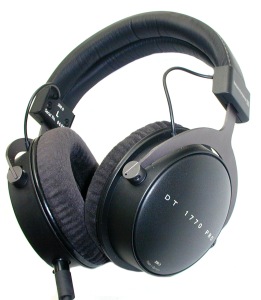
The Beyerdynamic DT 1770 Pro is a closed over-ear (circumaural) headphone with a Tesla-driver just like the Amiron and DT 1990 Pro. The DT 1770 has a similar tonal character as the DT 770 which is a much cheaper plastic version with a ‘lesser’ driver.
This headphone is not intended for portable usage as the impedance is a bit too high to be driven from phones/tablets and small DAP’s. It is intended for home and studio usage. The driver appears to be the same one that is used in the Amiron and DT 1990 and is 250Ω. With an MSRP of around € 600.- it isn’t one of the cheapest headphones around.
When looking around it can be found for prices between € 400.- and € 600.-
Build quality is high and the looks are premium as well. Definitely a step above the cheaper DT 770. The metal parts and headband as well as replaceable cable are of higher quality. Durability of the plastic parts of the DT770 are also excellent though.
The headband looks nicer and is a little more padded. height can be adjusted easily and is ‘stepped’ and clicks in place and stays there as well. The height adjustment is quite large so will fit on most heads. The forward and backward swivel is limited but enough for a good fit.
The cable is detachable. In the left cup there is a sturdy mini-XLR connector. Much to my surprise this is a 3-pin connector. I have no idea why they did not use a 4-pin variant. This would allow the DT1770 to be used on balanced amplifiers as well. Given these are high impedance it would make sense to use it balanced from portable gear.
So balanced amplifiers can not be used.
One straight 3m with gold plated 3.5 mm TRS plug + screw-on 6.3 mm adapter and a 5m (when fully stretched) coiled cable is supplied. This also indicates they aren’t intended for portable usage but is clearly aimed at studio and desktop usage.
Another gripe I have is the cable that runs from the headband to the cup has a tendency to touch the head. For balder folks this is clearly felt. this could have been solved by using a coiled wire or running it down to the cups on a different way.
The cable is quite microphonic alas so you can hear the cable rubbing against clothes in the left cup.
The pads are quite comfortable and provide a good seal. The velour feels soft and pleasant. There is enough room in there to fit even the bigger ears and enough depth so my ears don’t touch the drivers. The pleather pads are also comfortable and provide a bit better isolation from outside noises.
While the DT1990 is an open headphone the DT1770 is closed. The blockage of outside noises is decent but not enough for usage in planes.
People around you won’t hear your headphone playing music.
Despite its high impedance the efficiency is still quite good. This is because of the high magnetic strength of the magnets used in the drivers.
specifications:
Type: Over ear, closed
Usage: Home, studio
Driver type: dynamic (Tesla)
Pads: replaceable, velours pads are fitted, pleather (fake leather) in the box.
Foldable: No
Headphone connector: 3-pin mini XLR
Cable entry: single sided (left)
Cable: 3m with gold plated 3.5 mm TRS plug and 6.3 mm adapter
and a 5m (when fully stretched) coiled cable.
Driver size: 45 mm
Power rating: 0.2 W
Max. Voltage: 7V
Max current: 30mA
Max. S.P.L. 125 dB
Impedance: 250 Ω
Efficiency: 102 dB @ 1mW
Sensitivity: 108dB @ 1V (500Hz)
Weight: 388 g.
Clamping force: medium/high
Accessories: hard storage box, 6.3mm adapter, velour and pleather pads, 2 cables
Sound description:
Using the velour pads: Bass is present but not overpowering. The sound is very forward and ‘open’. Bass is a bit ‘disjoint’ from the mids as in not seamlessly integrated as with the DT1990. Bass is full, deep and ‘tight’ but sort-of separated from the rest of the music.
Most people will enjoy this as there is no bass-bleed into the mids.
The mids are clear but lack the ultimate clarity and detail as found in the DT1990.
Treble is slightly above neutral, much less so than the DT1990. The DT1770 does not have the same amount of ‘air’ and ‘finer nuances’ the DT1990 has. Treble is of fairly good quality, not ‘smooth’, not ‘splashy’ or coarse. Just present and not unpleasant.
It is not an easy task to find a good sounding closed headphone, the DT1770, out of the box has some very appealing qualities and does not sound ‘typically closed’.
Using the pleather pads: Bass is a bit more prominent with these pads and of lesser tonal accuracy. Bass is still separated from the mids but is ‘flabbier’ with a bit more ‘thumb’. Mids have a hollow-ish character. One could say the typical ‘closed headphone sound’ is audible with these pads. Isolation is somewhat better with these pads.
There is a somewhat more ‘presence’ in voices and instruments but this does not make up for the ‘closed’ sound one gets in return. The upper mids have a ‘weirdness’ to it with a ‘sharpish’ edge on instruments and voices. Tonally the headphone isn’t very wrong.
It is more in ‘technicalities’ and ‘details’ where the sound is a bit off. The treble is not refined, not smooth and soft but ‘present’ and clear.
The trade-off for better sound isolation is a small penalty in sound quality.
Using Dekoni Sheepskin pads: These pads are very comfortable and lower the perceived clamping force by spreading it over a large surface. In the end its all about the sound. These pads do not make this headphone sound hollow-ish as the pleather pads do and bass is better defined.
Bass is about the same as with the velour pads. Present but disjoint from the mids. The mids are different in character and more ‘midrangy’. Lacking some body in voices (not in overall sound). The mids are vivid and dynamic and sound quite ‘open’. Mids are lacking in ultimate clarity a bit but in a different way from the pleather pads. Treble is ‘coarser’ as in less refined. Treble does not sound elevated nor grainy and is on the proper level… just not refined/sparkly.
Using (grey) DT 770 pads with a passive filter: One can use these pads but without the filter it sounds as ‘fierce’ in the treble as the DT1990. So for me the filter is obligatory.
To me this is the best sounding combination.
Bass is perhaps slightly less in quality than the original velour pads. The difference is nitpicking territory. A little less ‘tight’ in the bass. On the other hand the mids are ‘smoother’ and less colored with a bit more clarity/presence but not as much as the DT1990. This is easier to listen to for longer periods. The transition between mids and treble is more seamless. Treble is detailed yet ‘smooth’ and a bit more ‘airy’ and refined.|
The sound is open clear, dynamic without a hint of this headphone being a closed version. I would say just below the DT1990 and for a closed headphone a very good sound. It requires buying extra pads and a filter. Without the filter the treble is too accentuated.
measurements:
Below the frequency response of the DT 1770 fitted with velours pads (Left, Right) The DT1770 has a present bass and excellent bass extension. The small ‘dip’ at 200Hz slightly ‘dis-attaches’ the bass from the mids. The mids themselves are good but slight warm/laid-back and could do with a hint more clarity/presence. The treble is the typical ‘Beyer treble’ which means ‘overly detailed/sharpish’ but better in quality than the much cheaper DT 770. Treble extension is decent.
The DT1770 has a present bass and excellent bass extension. The small ‘dip’ at 200Hz slightly ‘dis-attaches’ the bass from the mids. The mids themselves are good but slight warm/laid-back and could do with a hint more clarity/presence. The treble is the typical ‘Beyer treble’ which means ‘overly detailed/sharpish’ but better in quality than the much cheaper DT 770. Treble extension is decent.
Below the difference between the pleather pads and the velour pads.
(plots smoothed so tonal balance differences are easier to see)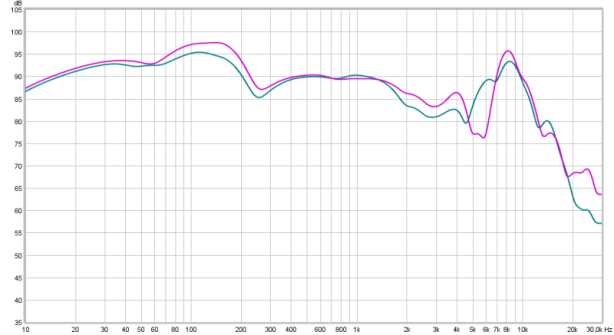
Bass is a bit more prominent with the pleather pads as is the clarity. Unfortunately the dip at 6kHz followed by the peak at 8kHz make the treble sound ‘coarse’ and less refined as when using the velour pads.
In tonal balance the DT 1770 Pro is somewhat similar to the DT 770 Pro (shown below).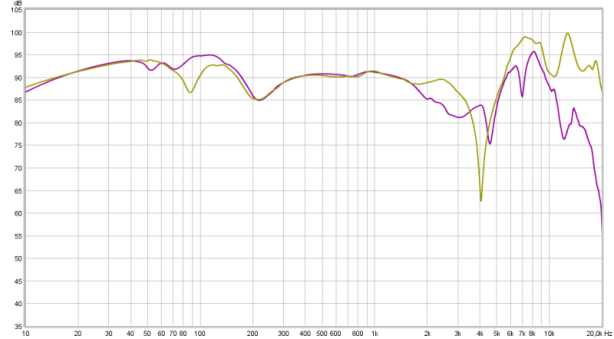
Bass in the DT 770 is always a bit ‘one-note’ to me and overblown. The bass in the DT1770 is ‘tighter’ and better in quality even though that is not apparent from the plots.
The DT1770 also is a bit less ‘present’ in clarity but still has enough clarity left.
The treble on the DT1770 is less ‘fierce’ as that of the DT 770 but not as ‘airy’ and detailed as the DT1990.
As the DT 1770 shares the same driver with the Amiron and DT 1990 (my opinion) a direct comparison is logical.
Below the frequency responses of the DT 1770, DT 1990 (B pads) and Amiron.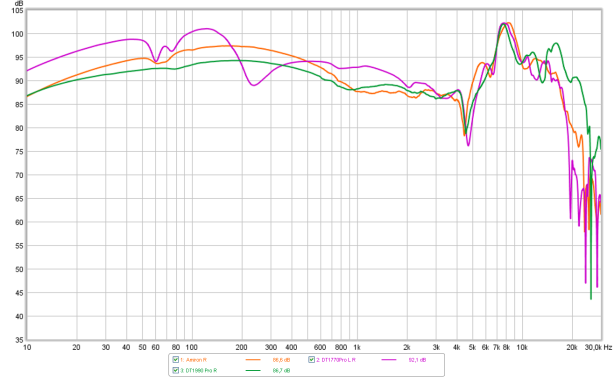
The treble peak (and small dip at 4.5kHz) are the same. The DT1990 has somewhat more upper treble extension giving it slightly more ‘air’ to the sound.
The Amiron home is warmer and bassier than the DT 1990. The DT 1770 is a bit more ‘impressive’ in the lows and sub-lows. What is obvious here is that the drivers in these headphones are probably the same and only the tuning below 2kHz differs.
more pad experiments
I bought this DT1770 second hand. It came with original pads (so I thought) and 2 different Dekoni pads. When fitting the velour pads it was immediately obvious something was very wrong. I bought a set of original pads and did a comparison.
DT1770 velour, DT1990-B, DT1990-A and Dekoni Elite Velour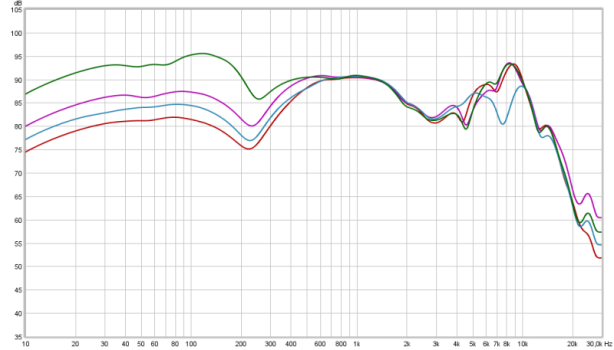 It is obvious that DT1990 pads do not work on this headphone as the bass and body simply is not present at all.
It is obvious that DT1990 pads do not work on this headphone as the bass and body simply is not present at all.
Seeing the DT1990 pads did not work and having measured original velour pads before, I tested DT 770 pads, the original pleather pads and Dekoni Sheepskin.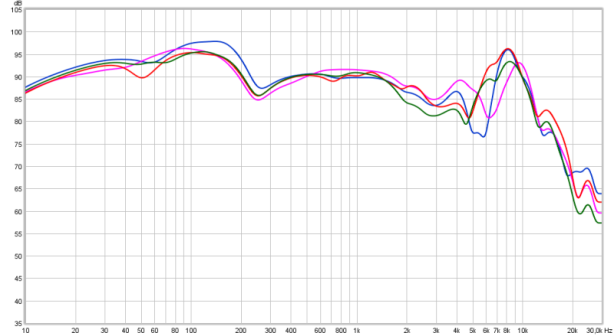
There is some difference in the lows. The original pleather pads are too boosted in the 150Hz area. The other 3 pads do not differ that much in the lows.
Differences are more obvious above 1.5kHz. The Dekoni is less ‘flat’ in the mids and have the most ‘presence’ around 4kHz making them ‘clearer’ sounding.
The Dekoni has a dip at around 6kHz and a peak at 10kHz. The effect is that the treble sounds a bit ‘coarse’.
A slightly different ‘coarseness’ is heard using the pleather pads. The wide and deep dip followed by a peak at 8kHz also makes the treble less ‘smooth’ and detailed.
The original velour pads sound good in the lows (better than pleather). The mids, however, are lacking a bit in ‘presence’ and lacks ‘details in the mids’.
Treble is not as boosted as the pleather pads and better in quality (not coarse)
The DT 770 pads (I used grey ones but these also exist in black) have a bit more clarity/presence but a higher 8kHz peak (there is a fix for that) and have a little higher level above 13kHz and sound more ‘airy’/’delicate’.|
The DT 770 pads (with the passive treble filter) sounds better to me (closer to the DT1990) than the original pleather pads. Without a filter the DT 770 pads sound too sharp in which case the original velour pads are a better choice.
Below 3 Beyer-pads in a row. On the left pleather DT1770, middle is DT1770 velour and on the right the DT 770 pad.
 These pads have the same diameter but the mounting ‘flap’ on the DT 770 pads is smaller.
These pads have the same diameter but the mounting ‘flap’ on the DT 770 pads is smaller.
This makes them a bit more difficult to fit. When removing the mounting ring from the DT1770 it is easier to fit the DT 770 pads. Below the DT1170 and DT 770 pads fitted on the removable mounting ring.
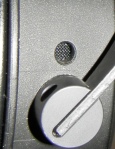 Porting
Porting
Just above the swivel point of the yoke there is a small port in each cup on the rear side. This port controls the bass boost.
Sealing this port partially will change the amount of bass.
Below a plot showing the change in the bass response when that port is (partially) sealed with a small sticker or tape.
Port open, port covered 50%, port covered 75%, Completely sealing the port removes all bass. When one feels the bass is a bit too much partially sealing the port is an option.
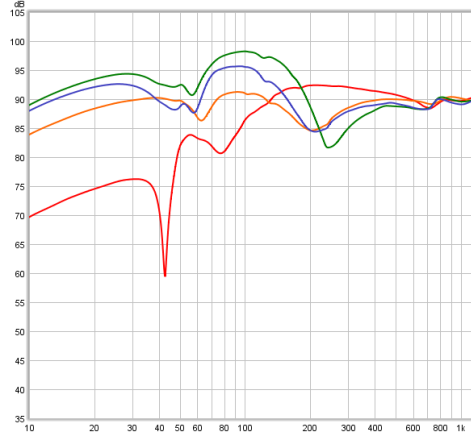
Seal
Seal can be an issue with closed-back headphones and is usually less of a problem for open headphones. Breaking the seal (improper fit on the head) usually means a loss of (sub)bass. Below the effect of a seal breach is shown using the DT1770 velour pads.
Perfect seal, Seal broken with thin armed glasses, Seal broken with a thick arm glasses.
The bass levels are (as expected) varying depending on the seal much more so than with the DT1990 which basically does not vary in bass levels.
The tonal balance does change when the fit isn’t perfect. Wearing glasses or having a not so great seal does have an audible effect.
output resistance / damping-factor
As this is a dynamic headphone the frequency response might be amplifier output resistance dependent when certain higher output resistance amplifiers are used.
To test this the headphone is measured via a low impedance amplifier (0.2Ω) and a high impedance amplifier (120Ω). On a higher output resistance amplifier the output level will be 3.1dB lower. To compensate for this the amplifier is cranked up to the same level (at 1kHz) as the low impedance amplifier. This way the plots are overlay-ed and it is easy to see how the tonal balance changes. (velour pads were used)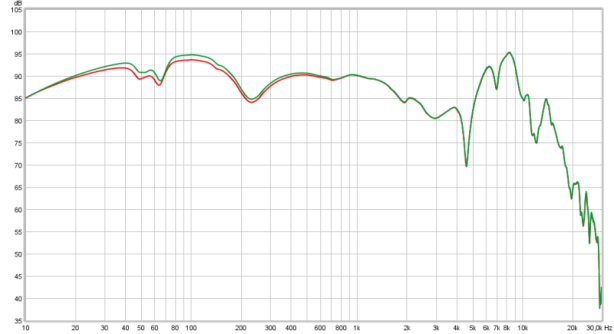 There is ‘only’ a 1.1dB boost in the lows. (Right channel is measured). Not something to be worried about and is just barely audible.
There is ‘only’ a 1.1dB boost in the lows. (Right channel is measured). Not something to be worried about and is just barely audible.
Below the differences in the waterfall response between 0.2Ω and 120Ω.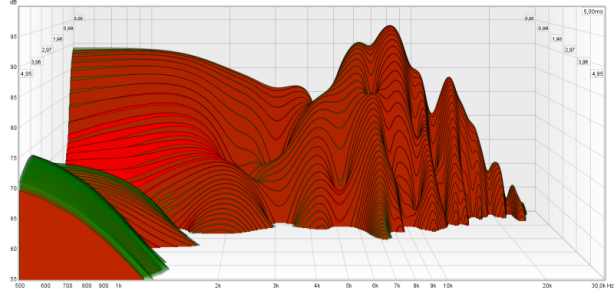
The higher output resistance has no influence on higher frequencies only somewhat on lower frequencies where the plot shows that aside from the small increase in level the damping is also worse. This headphone is best used from lower (< 10Ω) amplifiers.
Below the distortion measurements of the DT 1770 with velour pads (Left channel).
The plot above is in a dB scale, below the same measurement but in a percentage scale.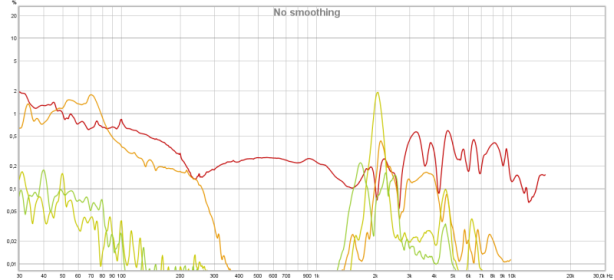
2nd harmonic and above all 3rd harmonic distortion levels are higher than those of the open DT1990 version. The distortion levels are not very high though. Only at around 2kHz the higher order distortion level is quite high. Above 2kHz 2nd harm. distortion levels reach 0.5% which is a bit on the high side for this price class.
Below the distortion measurements of the DT 1770 with pleather pads (Left channel).
The pleather pads have a bit higher 2nd harm. distortion in the lows and an (audible) level between 4kHz and 6kHz.
Below the distortion measurements of the DT 1770 with DT 770 pads (Left channel).
Not that much different from the DT1770 velour pads except for 3rd harmonics around 50Hz which reaches almost 5%. Otherwise overall slightly better than original velour pads.
Below the distortion measurements of the DT 1770 with Dekoni Sheepskin pads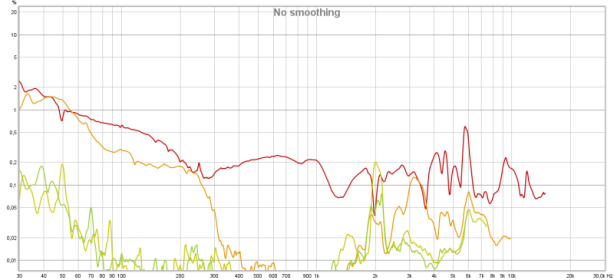
Distortion levels using the Dekoni Sheepskin are much better. The sheep supplying its skin did not do this more nothing it seems. While distortion levels are much lower than with Beyer pads the coarser treble (because of the dip at 5kHz) makes the death of this sheep less useful.
Time domain
Below the CSD of the DT 1770 with velour pads (Left and Right are superimposed)
Below the CSD of the DT 1770 with pleather pads 
Below the CSD of the DT 1770 with Dekoni Sheepskin pads 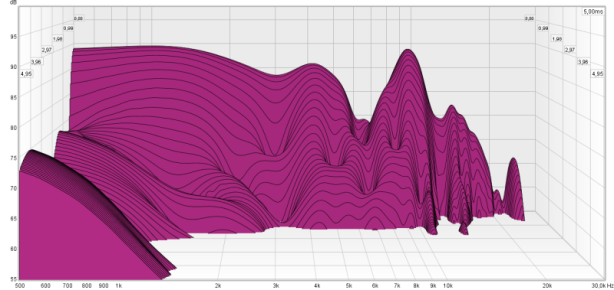
Below the CSD of the DT1770 with DT 770 pads using the passive filter
(Left and Right are superimposed)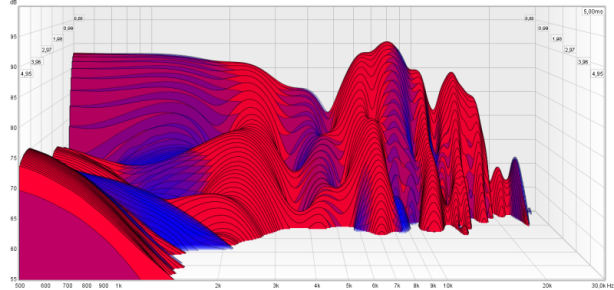
Another form of looking in the time domain is the spectrum plot. The amplitude is color coded and both the time scale and frequency scale differ as well.
Below the spectrum plot of the DT1770 fitted with velour pads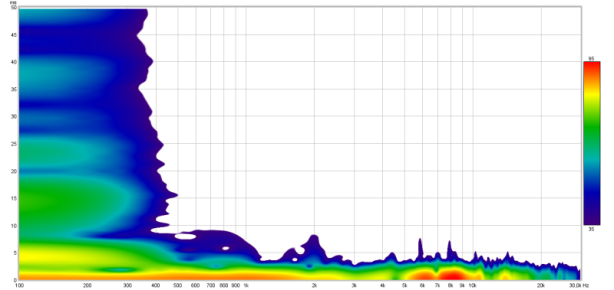
Below the spectrum plot of the DT1770 fitted with pleather pads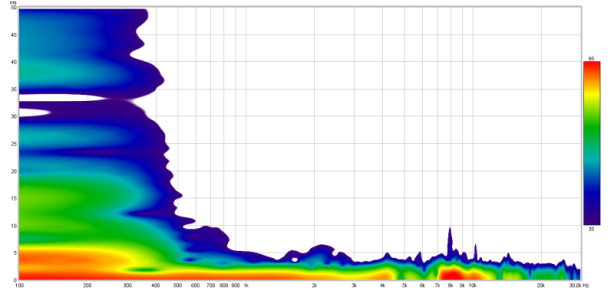
Below the spectrum plot of the DT1770 fitted with Dekoni sheepskin pads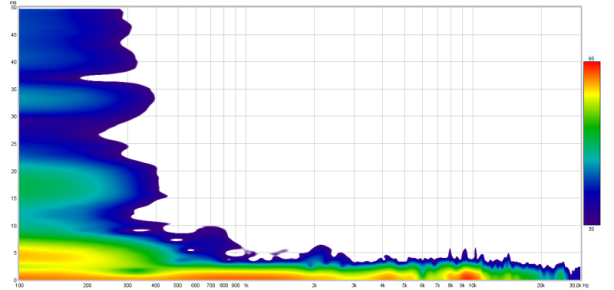
This is a bit cleaner above 5kHz.
Below the spectrum plot of the DT 1770 fitted with DT 770 pads (with filter)
Below the step response with a dB scale (so not similar to an oscilloscope plot which has a linear scale).
The step response (Left and Right channel overlaid) below shows a well extended bass response. The initial rise does not reach 0dB. This means treble extension isn’t as good as one may have hoped. The small peak around 200μs shows the treble is somewhat elevated. The small ‘hump’ around 2.5ms is evidence of the bass boost.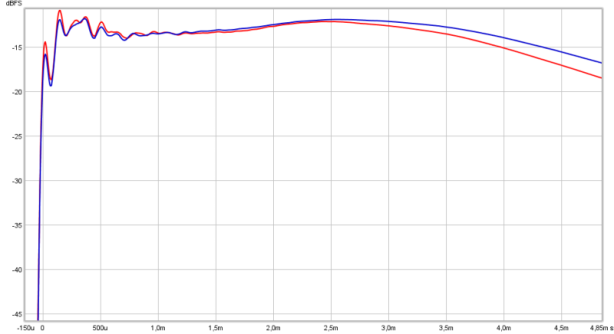
Below the difference between the velour and DT 770 pleather pads (without passive filter).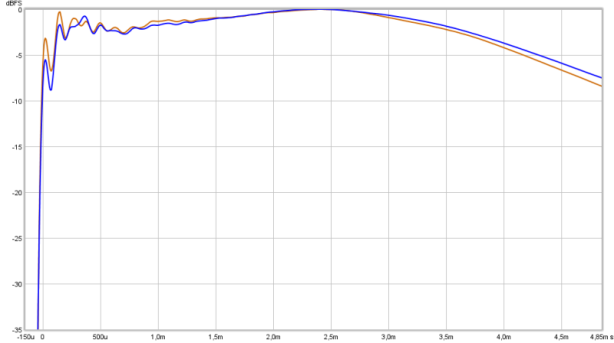 The clearer response is shown but also the overshoot opposite the area between 0.25ms and 1.5ms.
The clearer response is shown but also the overshoot opposite the area between 0.25ms and 1.5ms.
Below the velour pads versus DT 770 Pads with the passive filter.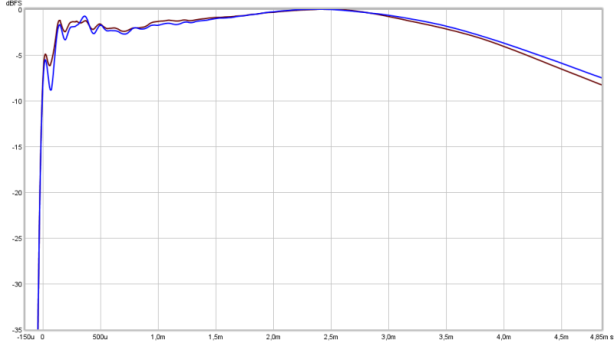 This shows equal impulse response as the original velour but with less wiggles.
This shows equal impulse response as the original velour but with less wiggles.
Below the difference between the velour and Pleather pads.
Below the difference between the Dekoni Sheepskin and Pleather pads.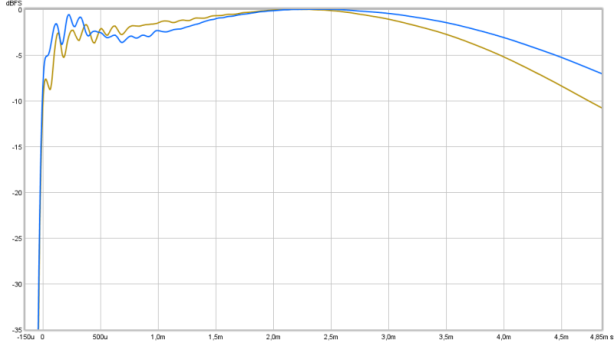
Best response is obtained with the DT 770 pads with the passive filter, closely followed by the original velour pads.
Square-wave and impulse response
Below the 40Hz and 440Hz square-wave response as well as a 100μs DC impulse.
The upper 3 screen-shots are made using DT 770 pads, the bottom 3 using the same pads but with the passive filter.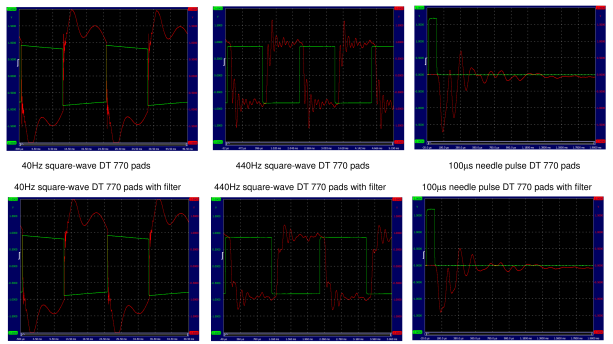 The most obvious thing in this plot is the fact that the phase is opposite from that of the DT1990 (as well as almost all other headphones).
The most obvious thing in this plot is the fact that the phase is opposite from that of the DT1990 (as well as almost all other headphones).
Fortunately this is so for both channels so has no audible consequences. It is strange though.
There is good bass extension as the 40Hz signal (the horizontal part) does not droop. The measured level is slightly higher than the applied (target) level and shows the bass response is elevated.
The 440Hz signal using the DT 770 pads looks like a square-wave. Obviously the filter has a positive effect on the ringing.
For the 100μs impulse the shape of the pulse, with the passive filter, is much closer to the original (just inverted in this case) and has shorter lived ringing.
Getting rid of the treble peak with DT 770 pads
The best way to get rid of the treble peak is to use a passive in-line filter. This filter lowers the treble peak to ‘normal’ levels and leaves the rest of the sound as it is.
Below the response of a slightly modified (port covered 50%) DT1770 fitted with DT 770 pads with and without the filter.
The 5dB reduction is quite audible and removes the sharpness.
Below the schematic for this filter (same as for DT1990).

When you can not make this filter yourself or don’t know someone that can do this for you a built filter can be ordered.
cables:
The DT1770 was bought second-hand and besides the extra Dekoni pads it also came with some very welcome shorter pads for portable usage. Both original cables have 3.5mm plugs with screw-on 6.3mm adapters so can be used but the long cables, especially the curled one, are very impractical for my use case.
4 cables… standard straight cable, standard coiled cable (is longer), a shorter cloth covered cable with an angled 3.5mm connector and a (silver ?) braided cable with a straight metal 3.5mm connector.
In the test setup the right cup is measured. This way I could exchange the cable (left cup) without moving the headphone too much. One has to unlock the headphone connector and exert some force pulling it out and plugging it in. This is impossible to do without moving the headphone at all. Even the slightest change in position will change the measurements making it impossible to compare the cables accurately.
Turned out I accidentally seemed to have slightly moved the right cup between the 2nd and 3rd measurement so can’t overlay all cables.
Below original pads DT1770 with 5m. (when stretched) coiled cable versus a 1m thin cloth covered cable
What can be seen is that the coiled cable has slightly more resistance and is fractionally lower in overall amplitude.
The slight difference around 50Hz is mains hum seeping in the measurement, ignore this.
Below original pads DT1770 with 3m original straight cable versus a short braided silver cable.
There is absolutely no difference between these cables as the purple trace of the original cable is fully overlaid with the teal trace.
Take this for what it is…
summary
The Beyerdynamic DT1770 Pro is an excellent performing (measurement and sound) closed headphone that is well made. Well suited for desktop and studio usage.
The build quality is very high. Comfort also is very good. They are quite expensive compared to the DT770-Pro but the sound quality is certainly better in all aspects.
Where the DT770 has a bit of a ‘one-note’ bass the bass quality and quantity of the DT1770 is certainly better.
It is not easy to find a good closed headphone. The DT1770 should definitely not be overlooked in this case. Certainly with DT770 pads with the passive filter the sound is very good for a closed headphone with none of the ‘typical closed headphones sound’.
The sturdy carrying case and pleather as well as velour pads are a nice addition. It is a good thing to have some choice in choosing pads without too much differences in sound signature.
The sound quality is very good and clearly belonging to the better closed headphones.
Not as neutral as the DT1990 but there certainly is a relation between the 2 models.
When an open headphone is no option the DT1770 is an excellent alternative.
Especially with the DT1770 pads and passive treble filter the sound quality is excellent.
Those looking for a good closed headphone should at least consider this headphone.
When you aren’t bothered by the typical (Beyer) treble peak this is a good sounding headphone.
Comfort improves using the Dekoni Sheepskin pads. The sound quality is not as good as the velour pads but is an alternative to the pleather pads.
Overall a rather expensive but beautifully made open headphone with a decent tonal balance and slightly elevated treble.
